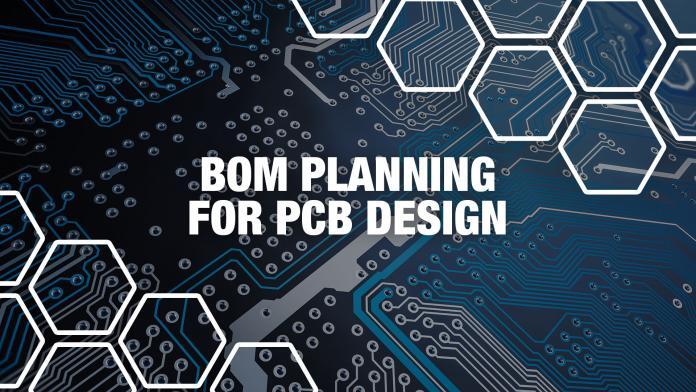The Bill of Materials (BoM) is a list of the raw materials, components, sub-assemblies, and other associated parts required to assemble and build an electronic product. It is required to plan and track the design and assembly of a PCB product. With the recent global shortage of semiconductor devices, meticulous planning of BoM is crucial to support the long-term production of PCBs.
Major concerns in the supply chain are shortage of components, longer lead times, and uncontrolled sale of counterfeit parts in the market. Due to the wide shutdown of the manufacturing industry in the last two years, the demand and production of silicon chips and other components have drastically fallen. Now, the production is picking the pace but the shortage and backlog will continue for some more time.
The international shipping of raw materials and other essential components had stopped due to the pandemic. Hence, the stock with most of the contract manufacturers has dipped leading to severe scarcity of the inventory. Taking advantage of this situation, many counterfeit component vendors have easily entered the electronics market. It is quite difficult to identify these fake parts. This has increased the concerns about product quality and functionality. Now the PCB designers are coming up with new strategies to address these issues.
A BoM can be prepared in several ways before you start PCB prototyping. Choosing a hierarchical or flat BoM depends on the complexity of the design and the intended users. The design engineer might find a flat BoM effective while a production engineer prefers a hierarchical BoM. Multiple variants of the same BoM can be created to share with different vendors, based on the amount of information to be disclosed.
BoM generator applications are embedded in the latest Electronic Design Automation (EDA) tools to ease the task of creating different BoM formats. A typical BoM includes the following information:
Manufacturer’s Name – Indicate the primary source of the component
Manufacturer’s Part Number – Mention the complete part number
Part Description – Include footprint and electrical specifications
Part Quantity – Total quantity of every component
Reference Designators – lists the correct designator for each part
Component phase – Product lifecycle to be ‘Active’ or ‘Prod’
Package type – mentioned for all ICs and discrete components
Placement method – Through-hole or surface mount type
BoM level (in Hierarchical BoM) – Helps to navigate easily and locate parts
Board layer information – Top or Bottom layer for component mounting
Unit of measure – Common unit is ‘each’, discrete parts can be in ‘reels’
Mount/No mount – Used for assembly assistance
Alternate parts – Helpful in planning for bulk productions
Notes – Includes reference documents, comments, warnings, etc.
All this information helps the procurement team to effectively plan for a successful PCB production. In the long-term PCB production, a few more BoM planning strategies can be included during the PCB design stage itself.
During the design stage, proactive data gathering on the component’s availability and its cost can be a great approach to begin. Typically, some of the circuit blocks are reused in new designs and the designer tends to keep the same old components. These components’ cost, lead time, or life cycle might have changed. So, verifying the component status before finalizing the design is always recommended. Along with the availability, it is important to verify the source validity to avoid procurement of counterfeit parts.
Exploring alternate options for the unavailable parts can evade shelving the design altogether. Alternate part listing helps in such situations. If there is no exact replacement possible, then re-designing the circuit can also be considered. Alternate solutions in the layout design can also be included. If there is a change in the alternate part’s footprint then the designer can provide both packages’ mounting options on the board. Based on the part availability, the BoM -Mount/No Mount list can be updated.
Once the initial functionality verification is completed, the designer can populate a basic BoM with major components. This can be used by the procurement team to plan for the PCB assembly. Usually, application-specific ICs (ASICs) are critical in achieving the required circuit functionality. Checking for the lead time of such parts in advance is highly recommended. Also, it is better to keep stock of such inventory to avoid any delay during PCB assembly.
If the BoM doesn’t meet the set quality standards, there can be several problems during the PCB assembly. Issues like component mismatch, higher cost, or longer lead times can delay the product release. BoM should indicate the correct part number with no ambiguity on the required quantity. Updating the inventory and maintaining an effective version control tool can avoid mistakes in the stock count of every component.
The parts included in the BoM should be verified to meet the allocated budget of the ultimate product, else the profit margin may reduce. It is always suggested to use standard parts in the PCB design to meet the performance requirements. Verifying the BoM multiple times before releasing it to the production team can catch issues like wrong components, incorrect quantity, or missing parts. This can save a lot of time and money when the product is designed for long-term production.
The BoM should address all important requirements of PCB production, starting from part availability, cost, lead time, and assurance on genuine component procurement. It also lists the sub-assemblies and mechanical parts required in the final product assembly. BoM automation can reduce the overhead of extensive data management. It can assist in keeping the design up to date and streamline the complete PCB assembly process. PCB production can be more effective by using BoM automation and rigorous planning.
While planning a PCB BoM, it is advised to reach out to an experienced CM in the initial design stages itself. CMs will have a dedicated procurement team and a wide network of suppliers. They can review the BoM and also monitor the availability, cost, and life cycle status of the components. When PCB production is planned for an extended duration, collaborating with an expert CM can be of great benefit.
You may also want to read,








